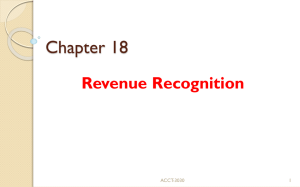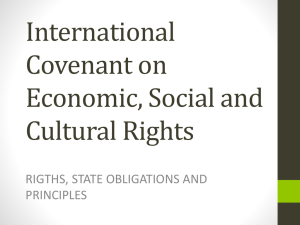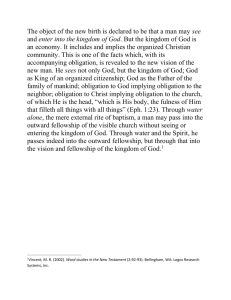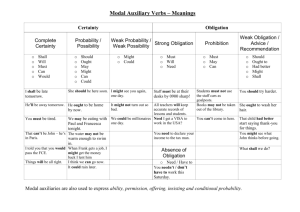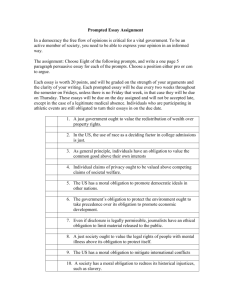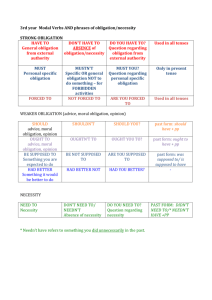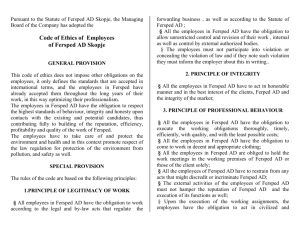An Action-Based Ontology Of Legal Relations
advertisement
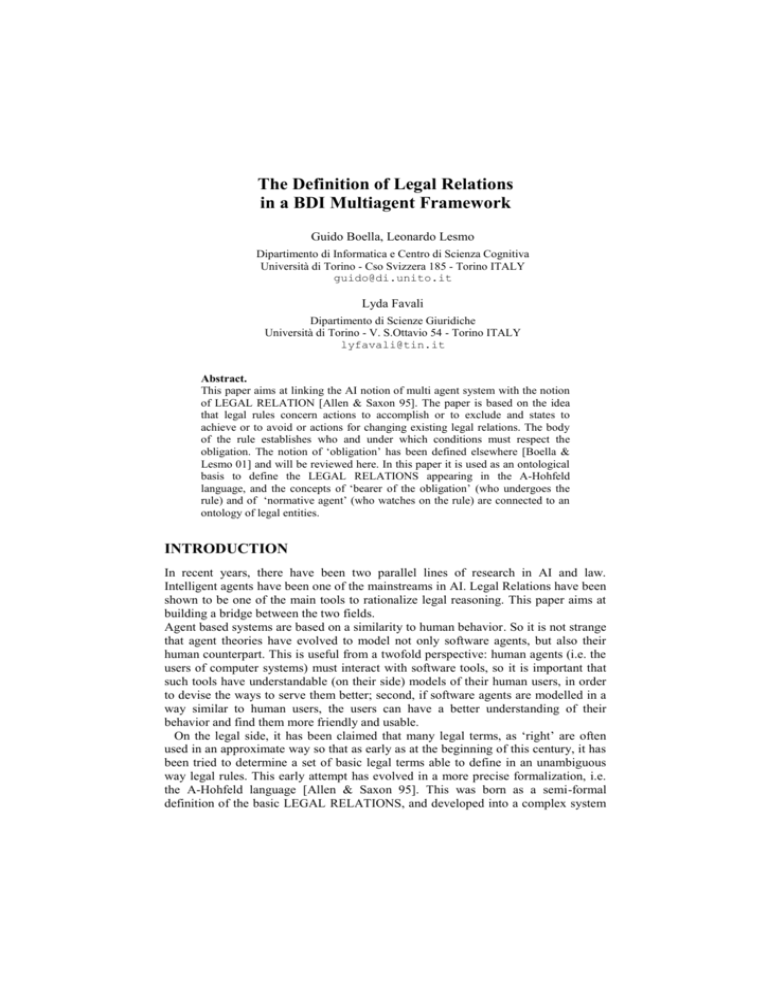
The Definition of Legal Relations
in a BDI Multiagent Framework
Guido Boella, Leonardo Lesmo
Dipartimento di Informatica e Centro di Scienza Cognitiva
Università di Torino - Cso Svizzera 185 - Torino ITALY
guido@di.unito.it
Lyda Favali
Dipartimento di Scienze Giuridiche
Università di Torino - V. S.Ottavio 54 - Torino ITALY
lyfavali@tin.it
Abstract.
This paper aims at linking the AI notion of multi agent system with the notion
of LEGAL RELATION [Allen & Saxon 95]. The paper is based on the idea
that legal rules concern actions to accomplish or to exclude and states to
achieve or to avoid or actions for changing existing legal relations. The body
of the rule establishes who and under which conditions must respect the
obligation. The notion of ‘obligation’ has been defined elsewhere [Boella &
Lesmo 01] and will be reviewed here. In this paper it is used as an ontological
basis to define the LEGAL RELATIONS appearing in the A-Hohfeld
language, and the concepts of ‘bearer of the obligation’ (who undergoes the
rule) and of ‘normative agent’ (who watches on the rule) are connected to an
ontology of legal entities.
INTRODUCTION
In recent years, there have been two parallel lines of research in AI and law.
Intelligent agents have been one of the mainstreams in AI. Legal Relations have been
shown to be one of the main tools to rationalize legal reasoning. This paper aims at
building a bridge between the two fields.
Agent based systems are based on a similarity to human behavior. So it is not strange
that agent theories have evolved to model not only software agents, but also their
human counterpart. This is useful from a twofold perspective: human agents (i.e. the
users of computer systems) must interact with software tools, so it is important that
such tools have understandable (on their side) models of their human users, in order
to devise the ways to serve them better; second, if software agents are modelled in a
way similar to human users, the users can have a better understanding of their
behavior and find them more friendly and usable.
On the legal side, it has been claimed that many legal terms, as ‘right’ are often
used in an approximate way so that as early as at the beginning of this century, it has
been tried to determine a set of basic legal terms able to define in an unambiguous
way legal rules. This early attempt has evolved in a more precise formalization, i.e.
the A-Hohfeld language [Allen & Saxon 95]. This was born as a semi-formal
definition of the basic LEGAL RELATIONS, and developed into a complex system
of EXTENDED LEGAL RELATIONS, claimed to cover all concepts useful for
describing legal rules [Allen & Saxon 98, 99].
But legal rules aim at constraining the behavior of the individual subject to them,
in order to make it compatible with a desired social harmony. So, there is an apparent
relationship between the legal system and multi agent systems. It seems reasonable to
attempt to connect the two points of view: formal models of behavior, and formal
models of constraints on behavior.
Most works in the field of AI and law have focused on the representational issues of
norms (see [Tiscornia & Turchi 97]) or on the problem of the possible combinations
of normative positions [Sergot 98]. On the contrary, in the MAS community, more
and more attention is being devoted to the problem of generating norm abiding
behavior and of modeling the decision process of agents under obligations ([Dignum
96], [Castelfranchi 98]).
In the past years, we have developed a model of agents, able to account for some
complex phenomena concerning human behavior in dialogue [Ardissono et al. 00],
and for the basic principles of rational behavior in the interaction with other agents
[Boella 00]. More recently, we have shown that this model is able to cope with
obligations [Boella & Lesmo 01].
In this paper, we want to draw a connection between these two fields by introducing
our treatment of norms and obligations in the definition of the Legal Relations of the
A-Hohfeld language [Allen & Saxon 95]. The main contribution of this attempt is to
make explicit the operational component underlying legal reasoning, which is left
implicit in many works, starting from [Allen & Saxon 95]. A new link is established
between a rule expressed in terms of Legal Relations, and the required behavior of
the individuals mentioned in the rule. On this basis, it is possible to define rules
which are applicable both to human and to software agents, and to introduce new
formal ways to reason about the applicability of rules.
The paper is organized as follows: the next section introduces the basic concepts of
the underlying model of agents; the third section gives a formal definition of
obligations; the last section shows how LEGAL RELATIONS can be specified in
terms of actions and obligations; finally, the Conclusions close the paper.
AGENTS, ACTIONS, AND OBLIGATIONS
Although the theory of BDI (Belief-Desires-Intentions) agents need not be examined
in depth in the present context, there are some aspects which are relevant. Perhaps,
the most important are that agents have goals and are capable to act in order to
achieve these goals. One of the aspects that are usually disregarded is where these
goals come from. It is usually assumed that an agent has personal desires that concur
in forming his goals; moreover, the social desire to maintain good relations with
other agents (i.e. social goals), or the necessity to coordinate cooperation (goal
adoption [Castelfranchi 98]) can lead to the formation of goals. But there is at least
another source of goals which we consider: it consists in obligations.
In previous papers, we outlined a theory of norms and a reasoning framework for
taking deliberations dealing with obligations, which is inspired by the work of
[Goffman 70] in the sociological field. According to Goffman, a norm is a kind of
guide to action which is supported by social sanctions. Moreover, he defines as
sanction a reaction of others to the behavior of an individual or a group, a reaction
aiming at enforcing the respect of a given norm. Hence, from the point of view of
sociology, norms come always together with sanctions; since sanctions are actions,
they presuppose, in turn, someone to perform them. As noted in [Tiscornia & Turchi
97]: “in general, every prescription requires a sanction. […] prescriptions are
autonomous norms, while sanctions exist in as far as there is also a prescription to
which they refer” (p.65). So, there is a strict dependence between sanctions and
norms, at least in most cases1.
We founded our theory of obligations on the following assumptions:
1. There exists a Bearer who must fulfill the prescription(s) carried by the
obligation.
2. The prescription is represented as an Action to be done, an Action not to be done,
a State to achieve, or a State to avoid.
3. There exists a Sanction, which can be applied in case the prescription is not
fulfilled. In principle, the sanction is an action which affects the bearer in a
negative way.
4. There exists a Normative Agent who acts in case the obligation is not fulfilled
and possibly her action results in the application of the sanction to the Bearer.
We have shown that such a formalization of obligations can be embedded in a MAS
which is based on the notion of goal adoption, anticipatory coordination
[Castelfranchi 98] and decision theoretic planning as the one presented in [Boella
00]. As stated above, the agent’s goals do not depend only on his own objectives but
he also has to take into account other agents’ goals, such as those proposed by
obligations.
Second, the decision about which goal to pursue cannot be made only on the basis of
the effects of the plan for achieving the different goals. In a multiagent setting, the
agent’s choices directly affect the behavior of other agents. As [Goffman 70] notices
in his discussion on strategic interaction, when an agent considers which course of
action to follow, before he takes a decision, he will depict in his mind the
consequences of his action for the other involved agents, their likely reaction, and the
influence of this reaction on his own welfare. He will adapt his actions to the other
agents' reaction before it can even happen.
If we want to cope with this kind of reasoning we need both a criterion for comparing
actions and some form of anticipatory coordination to predict the reactions of the
other agents involved in the interaction. To meet the first requirement, we adopted
decision theory so that we can characterize the preferences of an agent by means of a
utility function. On the other hand, anticipatory coordination means that the state that
results from the execution of an action (or, in general, a plan) cannot be used to
evaluate the utility of the action. Rather, each outcome of the agent’s action must be
first updated with the effects of the (predicted) reaction of the other agent. The other
1
Of course, there are exceptions; for instance, the so called ‘blank norms’ or ‘natural
obligations’ lack an explicit sanction component
agent must be (recursively) modeled as a BDI agent, with his own beliefs, goals and
preferences.
This is particularly relevant in the case of obligations. In this case, the ‘other
agents’ can be reduced to the Normative Agent, so that, in choosing what to do, the
Bearer of the obligation must try to foresee whether the Normative Agent will
sanction him in case he does not fulfill the obligation which the Normative Agent
must enforce.
It may well happen that the choice falls on a plan which does not fulfill the
obligation, in case all plans that fulfill it lead to a very negative state for the agent.
More interestingly, the Bearer could also devise plans to mislead (or corrupt) the
Normative Agent, so that the Sanction is not applied even if the obligation has not
been fulfilled. We have also argued that this modelling of dishonest agents (even if
morally questionable) could be essential in order to let Normative Agents recognize
dishonest behaviors.
As a consequence, norms need not be represented by another primitive
propositional attitude with a distinct ontological status, but as a combination of
beliefs and goals of the agent subject to the norm and of the agent who has to enforce
the respect of the norm: in particular, the goal of avoiding sanctions, the goal of not
violating the norm and the belief that there is another agent who has the goal of
sanctioning violations.
The technical tools we adopted to implement the model is decision theoretic
planning (i.e., non classical planning based on decision theory and/or game theory,
see [Haddawy & Hanks 98]). It is useful to remember that decision and game
theoretic planning have an important role in modelling multi agent situations, as, for
example, [Boutilier 99] and [Gmytrasiewicz & Durfee 00] have recently argued.
In this paper, we aim at showing that the same kind of formalization can highlight
some basic aspects of legal rules. In particular, we claim that obligations, if suitably
extended, can provide an ontological basis to the Legal Relations appearing in one of
the clearest formulations of the legal language, i.e. A-Hohfeld. This is not an attempt
to redefine A-Hohfeld, but just a description of how the legal language is related to
the behavior of agents.
A FORMAL DEFINITION OF OBLIGATIONS
In the definition of obligation, we assumed that it consists in a situation where an
agent N (the Normative Agent) has a goal G that another (or more than one) agent B
(the Bearer) satisfy a goal G’, and who, in every case the agent B acts without
adopting the goal G’, has to decide whether to perform an action Act which
(negatively) affects some aspect of the world which (presumably) interests B. Both
agents know these facts.
Differently from what appears at first sight, this definition covers not only
“institutional” cases, but also other situations like obligations in dialog (see [Boella
et al. 99] and [Ardissono et al. 00]) which share the characteristic that new goals are
acquired as a consequence of social inputs.
In the L component of an agent, an obligation is represented as a 5-tuple {B, N,
O, CO, R} where:
1.
B is the bearer of the obligation (actually the description of the class of
individuals to which the obligation applies; i.e. it is the type of the potential
bearers)
2. N is the normative agent (actually the type of the authorized normative agents)
3. O is the content of the obligation, i.e., the state or action goal which N wants to
be adopted by B,
4. CO is the condition of the obligation, i.e., the set of predicates specifying in
which states the obligation must be fulfilled,
5. R is an action (the sanction) which N will presumably bring about in case he
detects a violation of the obligation.
The content of the obligation , i.e. O, is not necessarily a state (e.g., ``the tank
must be full''), but it can be also an action where B is the agent (e.g., ``the agent
should send the credit card number") or not (e.g., ``The parent of the agent must
submit his personal certificate''). But it can also be the prescription of not executing
an action (``you should not send huge files by mails") or, almost equivalently, the
prescription not to achieve a state (``the tank must not be empty'') or to maintain it
true as in the current situation (``the door must remain closed'').
Of course, the sanction is executed only in case the normative agent believes that
there is a violation: in order to establish whether a violation occurred the normative
agent has to perform a monitoring action. For this reason, in our model, the sanction
R is represented by a plan to be executed by the normative agent that consists of a
monitoring action followed by the very action of affecting the world in a way that is
(negatively) relevant for the bearer agent.
Directed Obligations
One of the features which are present in the Language of LEGAL RELATIONS
(LLR) is the concept of directed obligation (an in-depth analysis of this concept
appears in [Herrestad & Krogh 95]). The idea is that most LR are directed to a
counterparty. This is not prescribed by the definition of obligation presented above.
Obviously, it is possible to extend the definition of obligation by introducing a third
privileged individual (beyond the bearer and the normative agent), who plays the role
of the beneficiary of the obligation. However, a closer inspection of the role of
Normative Agent suggests another solution.
The Normative Agent was introduced to model the institutional figure who has the
task to check that a particular set of obligations is respected (e.g., policemen)2.
However, it seems that this same role, complemented with the notion of utility we
2
Actually, there exists another important institutional figure, the Sovereign, who created the
obligation. Since the model presented in this paper is intended as a model of action under the
constraints of obligations (an not as a model of how norms are created), the Sovereign and
the Defender Agents have been merged in a single Normative Agent.
introduced above, can play the role of the counterparty. In fact, there is the possibility
that two conditions hold (in the definition of the obligation):
1. The Normative Agent is positively affected by the content O of the obligation
(i.e., he occurs among the Action Participants of O and the
execution/achievement of O provides him with an increase of utility).
2. The sanction consists in opening a legal procedure against the bearer (e.g. a
complaint).
In case these conditions hold, we say that the normative agent plays the role of
counterparty of the bearer of the obligation, and we call the obligations such that
these conditions hold Directed Obligations.
It seems that the concept of utility and the action-based formalization give
substance to the notion of benefit (note that these two notions are already present in
our framework for independent reasons): “when expressing such a preference, the
legal authority regards A to be a benefit for j (and j be the beneficiary of A)”
[Herrestad & Krogh, p.212] (in the quotation, A corresponds to our O, and j to our
Normative Agent). Of course, the evaluation of the utility is not carried out by A, but
by the legal authority (the Sovereign), who created the rule.
The conditions listed above mirror rather closely a clause in the definition of RIGHT
given in [Allen & Saxon 95, p.223]. But what is more important, [Allen & Saxon 95]
directly relates deontic notions with the behavior of the normative agent and, in turn,
of the legal system:
“Person-p1 has a Right that Person-p2 do s” means […] “IT IS OBLIGATORY THAT s be
done for Person-p1 by Person-p2” which, in turn, means operationally […]
IF
A. IT IS NOT SO THAT Person-p2 does s for Person-p1
THEN B. Person-p2 has violated her DUTY to Person-p1, AND
C. IF
Person-p1 seeks remedy in the legal system by Litigating
THEN the legal system will provide a remedy to
Person-p1 with respect to Person-p2
This is reported as an operational definition of RIGHT, in terms of how the legal
system will treat the matter. Since our perspective is operational, in the sense that we
model the behavior of agents, it is not strange that there is a strict correspondence. In
fact, our sanctioning of the failure to respect an obligation produces the same effect
in two steps: first, the counterparty sanctions the bearer by seeking remedy in the
legal system; then, the legal system will have the duty (expressed as a general
obligation to sanction who does not fulfill an obligation) to provide remedy. Note
that, in general, the sanction is not ‘obligatory’, unless explicitly stated, so that no
counterparty has the obligation to seek remedy. When the bearer of the obligation has
to decide whether to comply with the obligation he has to simulate the decision
process of the counterparty and see if he will choose to seek remedy (i.e., if he is
aware of a violation, if he knows how and if he can do so, if it is useful for him to do
so). Note that the normative agent, either with the role of counterparty or not, is not
necessarily the sovereign agent who created the norm (but see Footnote 2).
Finally, in case there is a counterparty, the act of seeking remedy is not an exercise of
POWER (see the definition in the next Section), since no new obligation of the legal
system is created, but just one of the conditions of application of an existing
obligation of the legal system (to provide remedy) is made true. In this case, the
Bearer will have to (recursively) simulate not only the reasoning of the Normative
agent but also how the legal system will decide to fulfill his obligation to provide
remedy to the violation (see [Boella & Lesmo 01] for a discussion on multiple levels
of recursive modelling).
In other situations, where the normative agent watches over the norm on the behalf of
some institution (e.g., a policeman), the sanction can be an exercise of POWER (e.g.,
creating the duty to pay a fine) or even some form of punishment affecting the utility
of the bearer of the norm.
OBLIGATIONS AND LEGAL RELATIONS
Given the definition of obligation described in the previous section, it is now possible
to provide a definition of the LEGAL RELATIONS. We will show the definition of
some of the 8 basic Relations. This should not be seen as a principled choice, but it
depends on space constraints. The dual versions can easily be produced.
The relation which is closer to the definition of obligation is DUTY:
Agent D has the DUTY to P iff
1. There exists an obligation O, such that
The Bearer XO of O is of type TX
The applicability condition of O is CO
The content of O is P
2. D is of type T X
3. The condition CO holds in the current situation
Clauses 2 and 3 are remarkable, since they impose some conditions on the definition
of DUTY. Clause 2 simply transfers to duties the requirement we set forth for
obligations that they are defined for specific subclasses of individuals. Clause 3
specifies that any duty is subject to certain conditions. This is partially in contrast
with the separation maintained in A-Hohfeld between basic and CONDITIONAL
LEGAL RELATIONS. We believe that in most cases DUTIES (as any other LEGAL
RELATION) is conditioned to a particular state of affair; clearly, in some special
cases, the condition can simply coincide with the truth value “True” (i.e. it always
holds), but we claim that these are just exceptions to the more common cases. Notice
that it is not specified if CO must be true at the outset or it can become true after
some particular action or event. In case there is an event that makes true a condition
previously false, then the DUTY is created (or comes about): operationally, this
means that from that moment the Bearer must adopt the goal specified by O and
decide to pursue it under the light of the anticipation of a possible sanction. Finally,
we must observe that there is a universal quantification implicit in the iff operator
“For each D and P, then …”, and that the agent variable D can occur in CO.
Agent A has the RIGHT to P towards agent D iff
1. There exists an obligation O, such that
The Bearer XO of O is of type TX
The Normative Agent YO of O is of type TY
The applicability condition of O is CO
The content of O is P
2. D is of type TX
3. The condition CO holds
4. YO has the role of Counterparty (i.e. it is positively affected by P and may apply
the sanction – seeking remedy against XO)
5. A is of type TY
This is directed RIGHT, as the presence of Counterparty (defined above) in clause 4
shows. It can be observed that the condition CO, being any general proposition
concerning the situation at hand, could require that Y O be in a given relation R with
the bearer of the obligation X O; in this case, the RIGHT applies just in case A is in
relation R with D.
Agent D has the PRIVILEGE to P iff
1. There exists no obligation O, such that
The Bearer XO of O is of type TX
The applicability condition of O is CO
The contents of O is P
2. Or, if such an obligation exists, either
3. D is not of type T X, or
4. The condition CO does not hold in the current situation
In other words, D has the PRIVILEGE to P if there is no obligation that prevents P,
or if such an obligation exists, it does not apply to D, or it does not apply in the
current situation. It can be observed that there is a difference between the explicit
statement of a privilege and the realization that a given action (P) is not explicitly
forbidden. In our view, this is an important matter, which concerns consistency in
law. As stated above, we assume that our proposal is in line with the basic
assumptions of Hohfeldian Legal Relations3. So, we do not argue against the
opportunity to include in the language relations as PRIVILEGE. In fact, it seems
clear that checking there are no duties that forbid a given action is a difficult task; so
it is not unreasonable that the legislator carries out this check just once, and then
states explicitly the existence of the privilege. The next time a case must be
examined, the full check of existing duties can be bypassed, and the privilege can be
applied. However, it seems also clear that stating a PRIVILEGE of D to P, while the
current set of rules also state that, in the same situation, D has the DUTY to P is an
inconsistency that should be avoided. Finally, notice that this is a liberal view of law:
you can do everything which is not explicitly forbidden. In principle, it is possible to
revert to a restrictive view: privileges are defined as basic, and duties as derivative.
3
It must be observed that some scholars have challenged the view of Allen and Saxon,
claiming that Privilege is not the absence of obligations, but the fact that no obligation
affecting the privilege can be created (“there should not exists any obligation such that …”).
In this case, you obtain something as: you cannot do anything, unless you are
explicitly allowed to4.
In order to define the next LEGAL RELATION, POWER, we need to introduce a
particular subset of actions. This does not affect the underlying ontologic
assumptions, but it simply enables us to introduce the recursion required by
POWER5:
An Obligation-Affecting-Action related to the LEGAL RELATION P is an action
such that, among its effects there is:
1. either a modification of the current set of obligations that produces P,
2. or the modification of the set of Obligation-Affecting-Actions such that this
modification produces P.
So in the first case, it is possible to introduce a new obligation (thus creating, for
instance, a new DUTY); in the second case, it is possible to introduce an action
whose agent creates an obligation (creating the POWER to create a DUTY), or an
action whose agent can introduce an action for creating an obligation (two-level
application of POWER, in LR terms), etc.
Agent D has the POWER to bring about that P iff
1. There exists an obligation-affecting-action R related to P, such that
The Agent XR of R is of type TR
The applicability condition of R is CR
2. D is of type T R
3. CR holds in the current situation
It can be observed that this definition is rather simple, with respect to the complexity
of the concept of POWER. A first reason is that it is not necessary to introduce the
notion of authority, since the fact that the action exists (with the specified
consequences) is sufficient: the ontology of actions is such that the presence of an
action says by itself that (under the defined conditions) the action will produce the
specified effects; it is just the type of effects which keeps apart the exercise of
POWER from any other action.
Finally, the recursive character of POWER is mirrored in the use of the recursive
obligation-affecting-action within the definition of POWER.
As [Jones & Sergot 96] discuss, the notion of power must be kept separate from
those of permission and practical possibility. In our model, the first notion is clearly
distinct from POWER, since one can have a POWER while having the DUTY not to
exercise it: if, instead, he does so, the violation of the DUTY may lead the normative
agent to sanction him according to the specification of the related obligation. On the
other hand, the practical possibility depends on the truth of the applicability
conditions of the obligation-affecting-action involved in the POWER.
4
Actually, what should be done is to substitute the basic concept of obligation with the
inverse concept of permission (actions that one can do without sanctions). Then, privileges
are defined in terms of permissions and duties in terms of absence of permissions. But the
underlying idea is the same.
5 Intuitively, POWER is the right to create some new obligations.
CONCLUSIONS
In this paper, we have shown that a theoretical framework based on actions and
agents can provide a useful basis for expressing the meaning of the LEGAL
RELATIONS appearing in the A-HOHFELD language. We claim that this enterprise
is useful for connecting the AI concept of agent-based system, and the legal concepts
of rule and obligation.
Acknowledgements
This work has been partially supported by Italian CNR project “Conoscenza, intenzioni e
comunicazione”.
REFERENCES
[Allen & Saxon 95] L.E.Allen, C.S.Saxon: “Better Language, Better Thought, Better
Communication: The A-HOHFELD Language for Legal Analysis”. Proc. 5th Int. Conf. on AI
and Law, College Park, Md., 219-228 (1995)
[Allen & Saxon 98] L.E.Allen, C.S.Saxon: “The Legal Argument Game of LEGAL
RELATIONS”. E Law –Murdoch Univ. Electronic J. Of Law, 5, n.3 (1998).
[Allen & Saxon 99] L.E.Allen, C.S.Saxon: “Application of Enriched Deontic LEGAL
RELATIONS: Federal Rules of Civil Procedure Rule 7(a), Pleadings”. Proc. 7th Int. Conf. on
AI and Law, Oslo, 80-89 (1999)
[Ardissono et al. 00] L.Ardissono, G.Boella, L.Lesmo: “Plan Based Agent Architecture for
Interpreting Natural Language Dialogue”, Int. J. Of Human-Computer Studies 52, (2000)
[Boella 00] G.Boella: Cooperation among Economically Rational Agents. PhD thesis. Univ. of
Torino (2000)
[Boella et al. 99] G.Boella, R.Damiano, L.Lesmo, L.Ardissono: “Conversational Cooperation:
the Leading Role of Intentions”. Proc. Amstelogue’99 Workshop on, Amsterdam (1999)
[Boella & Lesmo 01] G. Boella, L. Lesmo: “Deliberate Normative Agents”, in R. Conte and C.
Dellarocas: Social Order in multi-agent systems, Kluwer (to appear)
[Boutilier 99] C.Boutilier: “Multiagent Systems: Challenges and Opportunities for DecisionTheoretic Planning”. AI magazine 20, 35-43 (1999)
[Castelfranchi 98] C. Castelfranchi. Modeling social action for {AI} agents. Artificial
Intelligence, 103:157--182, 1998.
[Cohen & Levesque 90] P.R.Cohen, H.J.Levesque: “Intention is Choice with Commitment”.
Artificial Intelligence 42, 213-261 (1990)
[Conte & Castelfranchi 95] R.Conte, C.Castelfranchi: Cognitive and Social Action. UCL Press
(1995)
[F.Dignum 96] F.Dignum Atonomous agents and social norms. Proc. Of ICMAS'96 Workshop
on Norms, Obligations and Conventions, (1996)
[Gmytrasiewicz & Durfee 00] P.J.Gmytrasiewicz, E.H.Durfee: “Rational Coordination in
Multi-Agent Environments”. Autonomous Agents and Multi-Agent Systems 3, 319-350 (2000)
[Goffman 70] E. Goffman, Strategic Interaction, Basic Blackwell, Oxford (1970)
[Haddawy & Hanks 98] P.Haddawy, S.Hanks: “Utility models for goal-directed, decisiontheoretic planners”. Computational Intelligence 14, 392-429 (1998)
[Herrestad & Krogh 95] H.Herrestad, C.Krogh: “Obligations Directed from Bearers to
Counterparties”. Proc. 5th Int. Conf. on AI and Law, College Park, Md., 210-218 (1995)
[Jennings 00] N.R.Jennings: "On Agent-Based Software Engineering". Artificial Intelligence
117, 277-296 (2000)
[Jennings et al. 98] N.R.Jennings, K.Sycara, M. Wooldridge: “A Roadmap of Agent Research
and Development”, Autonomous Agents and Multi-Agent Systems 1, 275-306 (1998).
[Jones & Sergot 96] A. Jones, M.J. Sergot, A Formal Characterisation of Institutionalised
Power. Journal of IGPL, 4(3) 429-455, (1996)
[Sergot 98] M.J. Sergot, Normative positions. In P.McNamara, H.Prakken (eds) Norms, Logics
and Information Systems. IOS Press (1998)
[Tiscornia & Turchi 97] D. Tiscornia, F. Turchi: “Formalization of Legislative Documents
Based on a Functional Model”. Proc. 6th Int. Conf. on AI and Law, Melbourne, 63-71 (1997)
